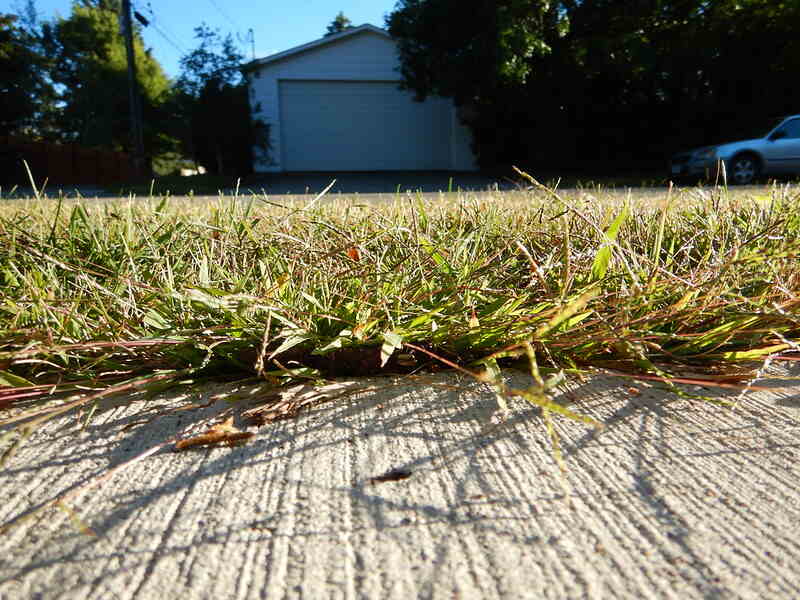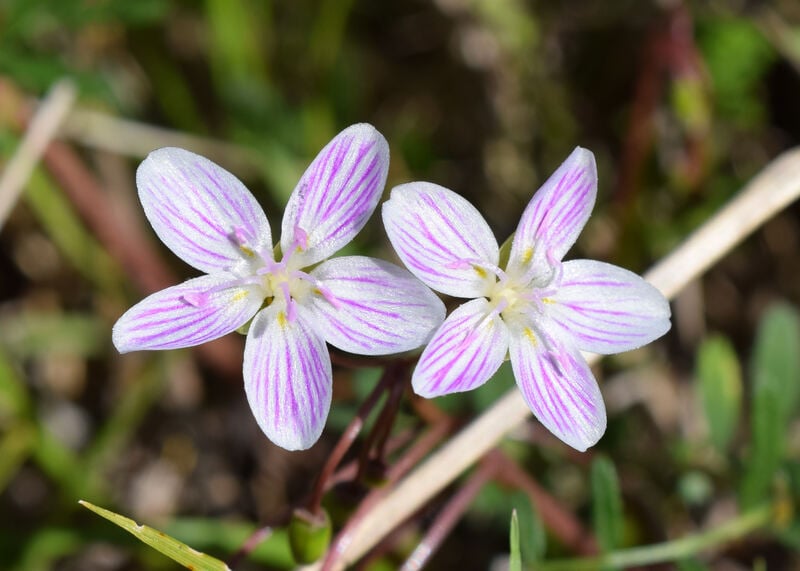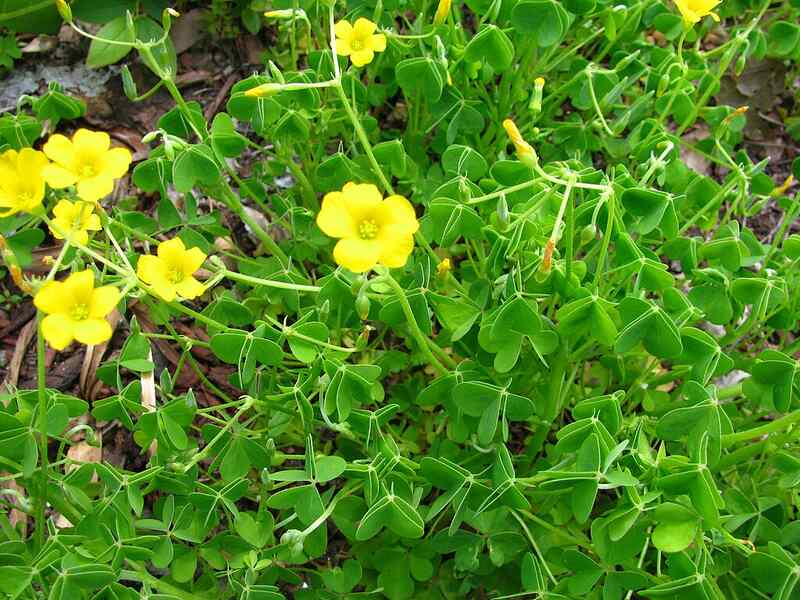
The most common lawn weeds in Mississippi are nutsedge, crabgrass, and hairy crabweed. However, other weeds like Carolina Geranium, Dallisgrass, Spring Beauty, and Chamberbitter are also common and can make a mess of your lawn.
Any effective weed control strategy starts with identifying the weeds plaguing your yard because some treatments work better on different varieties of weeds than others. We’ll discuss Mississippi’s most common weeds and how to identify and control them.
- Types of Weeds
- Most Common Weeds in Mississippi
- Nutsedge (Cyperus spp.)
- Crabgrass (Digitaria spp.)
- Hairy Crabweed (Fatoua villosa)
- Carolina Geranium (Geranium carolinianum)
- Dallisgrass (Paspalum dilatatum)
- Shepherd’s Purse (Capsella bursa-pastoris)
- Spring Beauty (Claytonia virginica L.)
- Hairy Bittercress (Cardamine hirsuta)
- Chamberbitter (Phyllanthus urinaria)
- Yellow Woodsorrel (Oxalis stricta)
- Controlling Weeds in Mississippi
- FAQ
Types of Weeds
Most weeds come in two varieties: broadleaf weeds and grassy weeds.
- Broadleaf weeds have netlike veins in their leaves, nodes containing one or more leaves, and showy flowers. Their growth habits and leaf structure set them apart from grasses.
- Grassy weeds start as a single leaf before developing hollow, rounded stems and closed, hard joints. Because they look like part of your lawn, they’re hard to find at first.
Weeds can either be annual or perennial.
- Annual weeds germinate, grow, and die in a year. They seed in the spring, grow in summer, and die in fall.
- Perennial weeds grow for two or more years if they aren’t removed. They become dormant in winter and return once temperatures start rising.
Most Common Weeds in Mississippi
Nutsedge (Cyperus spp.)

Nutsedge is so aggressive and invasive that one plant can cause an infestation. It likes moist areas of your lawn and quickly grows in the Magnolia State’s warm weather.
Two types of nutsedge grow in Mississippi: yellow and purple. Yellow nutsedge has yellow leaves and flowers, while purple nutsedge has dark green leaves and purple flowers. Their triangular or V-shaped stems set them apart from the grass they grow in.
Appearance: Sedge
Life Cycle: Perennial
Best Way to Control It: Herbicides, proper moisture levels, changing landscape plantings to add more shade.
For more information, check out our nutsedge control guide.
Crabgrass (Digitaria spp.)

Crabgrass germinates in spring, grows in summer, and dies with the first frost. It likes hot weather and drought conditions and its rapid growth makes it extremely hard to contain.
Crabgrass tends to sprout when your lawn is unhealthy. For example, mowing your lawn too frequently or too short helps it grow while the rest of your lawn is stressed out. Watering your lawn insufficiently gives it enough moisture to grow at the expense of the rest of your lawn.
Appearance: Grassy
Life Cycle: Annual
Best Way to Control It: Maintain a healthy lawn, use corn gluten meal, apply pre-emergent herbicides.
Check out our crabgrass control article for more information.
Hairy Crabweed (Fatoua villosa)

Also known as mulberryweed, hairy crabweed is an annual that gets its name from its hairy leaves and stems. It sprouts clusters of petal-less flowers that range from green to purple.
Hairy crabweed prefers moist, shady areas. Once it finds a suitable habitat, it will produce millions of seeds and spread uncontrollably.
Appearance: Broadleaf
Life Cycle: Annual
Best Way to Control It: Add a 2-inch layer of mulch, apply pre-emergent herbicide.
Carolina Geranium (Geranium carolinianum)

Carolina geranium is a winter annual with long stems that range from green to red. At the tips of these stems are flowers that have five petals and range from white to pink. However, it is most commonly identified by its long, pointed head that produces multiple seeds and can withstand prolonged dormancy underground.
Carolina geranium commonly occurs in poor soils and near dry areas like landscape beds and thin turf. Once established, it’s hard to control with herbicides.
Appearance: Broadleaf
Life Cycle: Annual
Best Way to Control It: Proper lawn care, herbicide, pulling them out by hand, mowing.
Dallisgrass (Paspalum dilatatum)

Dallisgrass is a perennial bunchgrass with short rhizomes and thick fibrous roots. It has a hairy, red-tinged base that’s usually inflated. It likes clay and loamy soils and is well-adapted to central and southern Mississippi.
Dallisgrass grows and produces seeds rapidly, which tends to smother and keep other native grasses from flourishing. The best way to control it is to dig out young plants before they form rhizomes or set seed.
Appearance: Broadleaf
Life Cycle: Perennial
Best Way to Control It: Dig out young weeds, use herbicides, maintain your lawn.
Shepherd’s Purse (Capsella bursa-pastoris)

Shepherd’s purse is an annual that blooms during the spring to mid-summer. After the flowers come flat pointed seedpods that are said to resemble the leather purses of shepherds during the Middle Ages, hence the name.
Shepherd’s purse grows in any cultivated soil or lighting situation except for heavy shade. When grown on salty land, it will absorb the salt and sweeten the soil.
Appearance: Broadleaf
Life Cycle: Annual
Best Way to Control It: Till and mow before it flowers, use herbicides (particularly, dicamba and metsulfuron).
Spring Beauty (Claytonia virginica L.)

As its name implies, spring beauty is considered a “sign of spring” because it’s one of the earliest blooming flowers. These flowers are pink or white with darker pink veins. Its seeds are small and are released when the capsule fruit breaks open.
Spring beauty has a short life span, so many choose to leave it alone and admire its beauty. Its low growing habit means mowing won’t keep it in check.
Appearance: Broadleaf
Life Cycle: Perennial
Best Way to Control Them: Leave it alone (it has a short life span), use broadleaf herbicides, use proper lawn control practices
Hairy Bittercress (Cardamine hirsuta)

Hairy bittercress is either a winter or summer annual, depending on the location. Alternately arranged leaflets grow on its branching stems, which can grow up to 12 inches. At the end of these stems is a flower consisting of four white petals.
Improving drainage helps deter hairy bittercress unless you have severe infestations. In this case, you’ll need chemical treatment.
Appearance: Broadleaf
Life Cycle: Annual
Best Way to Control It: Improving drainage, post-emergent herbicides.
Chamberbitter (Phyllanthus urinaria)

Also known as gripeweed, leafflower, or little mimosa, chamberbitter is an annual that emerges around May or June when the soil temperatures hit around 70°F. It grows tall and thin with smooth leaves. It produces numerous seeds over a large area.
Chamberbitter has an extensive root system and a high shade tolerance. It germinates later in the spring than most weeds, making it hard to control.
Appearance: Broadleaf
Life Cycle: Annual
Best Way to Control It: Mow frequently, pull weeds by hand, use herbicides
Yellow Woodsorrel (Oxalis stricta)

Yellow woodsorrel is a low-spreading perennial with clover-like leaves and yellow flowers (see our article comparing clover and oxalis). It grows fastest in spring or fall and prefers soils that range from dry to moist and well-drained.
Once established, yellow woodsorrel is extremely hard to remove, so make sure its seeds don’t germinate. Removing weeds by hand is an effective countermeasure, as are most pre-emergent herbicides.
Appearance: Broadleaf
Life Cycle: Perennial
Best Way to Control It: Use pre- and post-emergent herbicides.
Controlling Weeds in Mississippi
There are two ways to remove weeds – manually or with herbicides.
Manual weed control is time-consuming and laborious, but you don’t have to use chemicals. Either remove the weeds by hand or use a tool.
If there are too many weeds to pick out by hand, herbicides are the way to go. Choose between pre-emergent herbicides and post-emergent herbicides depending on the situation:
Check out our guide on weed control to learn more about herbicides and various other weed prevention tactics.
FAQ
Can I use mulch to kill weeds?
It helps. Mulch blocks weeds from getting sunlight and prevents new weeds from sprouting.
Why are weeds bad for my lawn?
Because they steal water, sunlight, and nutrients from plants that need them. In the process, they make your lawn weaker and more vulnerable to disease, infestation, and drought.
Why do weeds appear in my lawn?
Weeds appear for the following reasons:
- Compacted soil
- Poor drainage
- Lower pH soils
- Mowing too short
- Not enough water
What Mississippi grass types resist weeds?
Zoysiagrass and centipedegrass can both crowd out weeds due to their growth pattern. You can read about them and other varieties in our Mississippi grass guide.
Hiring a Professional
Countless Mississippi weeds threaten to steal valuable sunlight, water, and nutrients from your lawn. But with proper lawn care and weed control, you can bring these thieves to justice. And we can help – we have lawn care pros across the Magnolia State who will eradicate these weeds and keep them from coming back.
Main Image Credit: Spring Beauties / Arthur T. LaBar / Flickr / CC BY 2.0